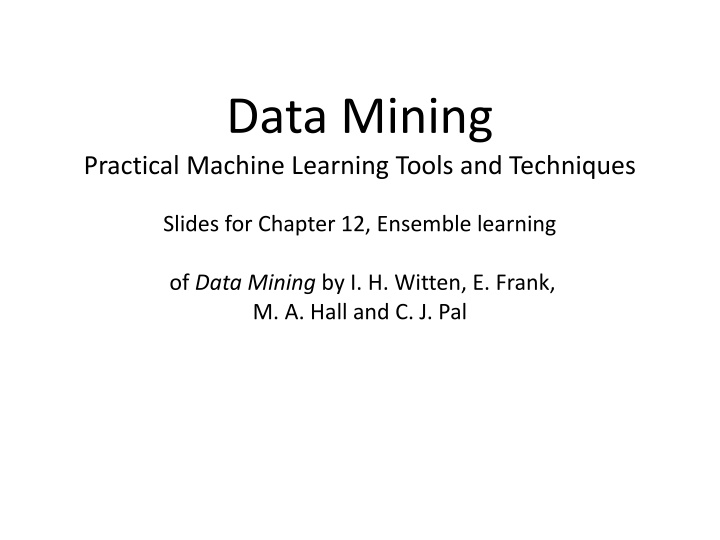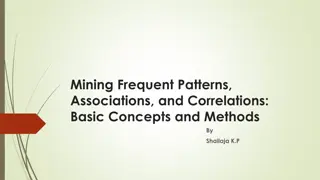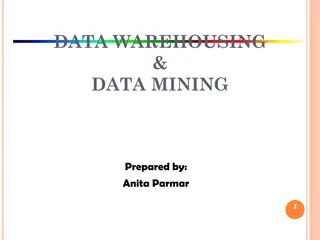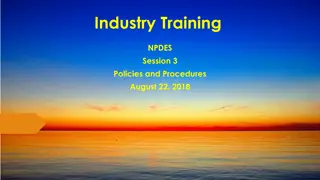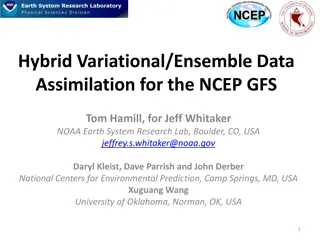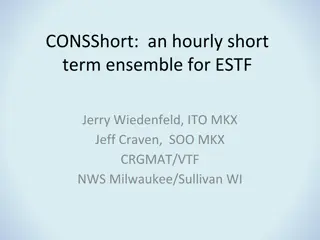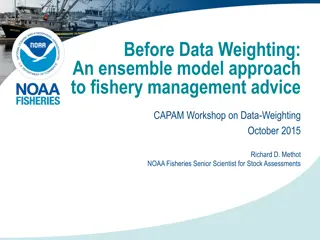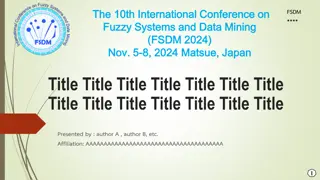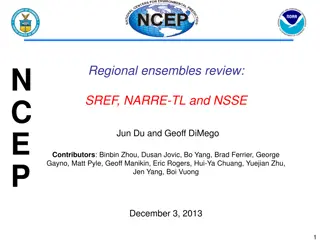Ensemble Learning in Data Mining: Tools and Techniques
Ensemble learning in data mining involves combining multiple models to improve predictive performance. Techniques such as bagging and boosting are utilized to create a single, more accurate model from diverse experts. The bias-variance decomposition is employed to analyze the impact of training set restrictions on performance, leading to a better understanding of prediction errors. Bagging, in particular, involves combining predictions from multiple models to enhance performance by reducing variance. This approach is effective for unstable learners and can significantly boost overall accuracy.
Download Presentation

Please find below an Image/Link to download the presentation.
The content on the website is provided AS IS for your information and personal use only. It may not be sold, licensed, or shared on other websites without obtaining consent from the author.If you encounter any issues during the download, it is possible that the publisher has removed the file from their server.
You are allowed to download the files provided on this website for personal or commercial use, subject to the condition that they are used lawfully. All files are the property of their respective owners.
The content on the website is provided AS IS for your information and personal use only. It may not be sold, licensed, or shared on other websites without obtaining consent from the author.
E N D
Presentation Transcript
Data Mining Practical Machine Learning Tools and Techniques Slides for Chapter 12, Ensemble learning of Data Mining by I. H. Witten, E. Frank, M. A. Hall and C. J. Pal
Ensemble learning 12.1 Combining multiple models The basic idea 12.2 Bagging Bias-variance decomposition, bagging with costs 12.4 Boosting AdaBoost, the power of boosting 12.7 Stacking 2
Combining multiple models Basic idea: build different experts , let them vote Advantage: often improves predictive performance Disadvantage: usually produces output that is very hard to analyze but: there are approaches that aim to produce a single comprehensible structure 3
Bagging Combining predictions by voting/averaging Each model receives equal weight Idealized version: Sample several training sets of size n (instead of just having one training set of size n) Build a classifier for each training set Combine the classifiers predictions Learning scheme is unstable almost always improves performance Unstable learner: small change in training data can make big change in model (e.g., when learning decision trees) 4
Bias-variance decomposition The bias-variance decomposition is used to analyze how much restriction to a single training set affects performance Assume we have the idealized ensemble classifier discussed on the previous slide We can decompose the expected error of any individual ensemble memberas follows: Bias = expected error of the ensemble classifier on new data Variance = component of the expected error due to the particular training set being used to built our classifier Total expected error = bias + variance Note (A): we assume noise inherent in the data is part of the bias component as it cannot normally be measured Note (B): multiple versions of this decomposition exist for zero-one loss but the basic idea is always the same 5
More on bagging The idealized version of bagging improves performance because it eliminates the variance component of the error Note: in some pathological hypothetical situations the overall error may increase when zero-one loss is used (i.e., there is negative variance ) The bias-variance decomposition was originally only known for numeric prediction with squared error where the error never increases Problem: we only have one dataset! Solution: generate new datasets of size n by sampling from the original dataset with replacement This is what bagging does and even though the datasets are all dependent, bagging often reduces variance, and, thus, error Can be applied to numeric prediction and classification Can help a lot if the data is noisy Usually, the more classifiers the better, with diminishing returns 6
Bagging classifiers Model generation Let n be the number of instances in the training data For each of t iterations: Sample n instances from training set (with replacement) Apply learning algorithm to the sample Store resulting model Classification For each of the t models: Predict class of instance using model Return class that is predicted most often 7
Bagging with costs Bagging unpruned decision trees is known to produce good probability estimates Where, instead of voting, the individual classifiers' probability estimates are averaged Note: this can also improve the zero-one loss Can use this with the minimum-expected cost approach for learning problems with costs Note that the minimum-expected cost approach requires accurate probabilities to work well Problem: ensemble classifier is not interpretable MetaCost re-labels the training data using bagging with costs and then builds a single tree from this data 8
Boosting Bagging can easily be parallelized because ensemble members are created independently Boosting is an alternative approach Also uses voting/averaging But: weights models according to performance Iterative: new models are influenced by performance of previously built ones Encourage new model to become an expert for instances misclassified by earlier models Intuitive justification: models should be experts that complement each other Many variants of boosting exist, we cover a couple 9
Boosting using AdaBoost.M1 Model generation Assign equal weight to each training instance For t iterations: Apply learning algorithm to weighted dataset, store resulting model Compute model s error e on weighted dataset If e = 0 or e 0.5: Terminate model generation For each instance in dataset: If classified correctly by model: Multiply instance s weight by e/(1-e) Normalize weight of all instances Classification Assign weight = 0 to all classes For each of the t (or less) models: For the class this model predicts add log e/(1-e) to this class s weight Return class with highest weight 10
Comments on AdaBoost.M1 Boosting needs weights but can adapt learning algorithm ... or can apply boosting without weights: Resample data with probability determined by weights Disadvantage: not all instances are used Advantage: if error > 0.5, can resample again The AdaBoost.M1 boosting algorithm stems from work in computational learning theory Theoretical result: Training error decreases exponentially as iterations are performed Other theoretical results: Works well if base classifiers are not too complex and their error does not become too large too quickly as more iterations are performed 11
More comments on boosting Continue boosting after training error = 0? Puzzling fact: generalization error continues to decrease! Seems to contradict Occam s Razor Possible explanation: consider margin (confidence), not just error A possible definition of margin: difference between estimated probability for true class and nearest other class (between 1 and 1) Margin continues to increase with more iterations AdaBoost.M1 works well with so-called weak learners; only condition: error does not exceed 0.5 Example of weak learner: decision stump In practice, boosting sometimes overfits if too many iterations are performed (in contrast to bagging) 12
Stacking Question: how to build a heterogeneous ensemble consisting of different types of models (e.g., decision tree and neural network) Problem: models can be vastly different in accuracy Idea: to combine predictions of base learners, do not just vote, instead, use metalearner In stacking, the base learners are also called level-0 models Meta learner is called level-1 model Predictions of base learners are input to meta learner Base learners are usually different learning schemes Caveat: cannot use predictions on training data to generate data for level-1 model! Instead use scheme based on cross-validation 13
Generating the level-1 training data Training data for level-1 model contains predictions of level-0 models as attributes; class attribute remains the same Problem: we cannot use the level-0 models predictions on their training data to obtain attribute values for the level-1 data Assume we have a perfect rote learner as one of the level-0 learner Then, the level-1 learner will learn to simply predict this level-0 s learners predictions, rendering the ensemble pointless To solve this, we generate the level-1 training data by running a cross-validation for each of the level-0 algorithms Then, the predictions (and actual class values) obtained for the test instances encountered during the cross-validation are collected This pooled data obtained from the cross-validation for each level-0 model is used to train the level-1 model 14
More on stacking Stacking is hard to analyze theoretically: black magic If the base learners can output class probabilities, use those as input to meta learner instead of plain classifications Makes more information available to the level-1 learner Important question: which algorithm to use as the meta learner (aka level-1 learner)? In principle, any learning scheme In practice, prefer relatively global, smooth models because base learners do most of the work and this reduces the risk of overfitting Note that stacking can be trivially applied to numeric prediction too 15
